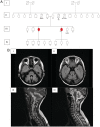Extending the Phenotypic Spectrum Associated with STUB1 Mutations: A Case of Dystonia
- PMID: 32258232
- PMCID: PMC7111583
- DOI: 10.1002/mdc3.12914
Extending the Phenotypic Spectrum Associated with STUB1 Mutations: A Case of Dystonia
Abstract
Background: Mutations in the STIP1 homology and U-box containing protein 1 gene were first described in 2013 and lead to disorders with symptoms including ataxia and dysarthria, such as spinocerebellar autosomal-recessive ataxia type 16 (SCAR16), Gordon-Holmes syndrome, and spinocerebellar ataxia type 48. There have been 15 families described to date with SCAR16.
Cases: We describe a 45-year-old right-handed woman with dysarthria, ataxia, and cervical dystonia with SCAR16 with 2 compound heterozygous variants in the STIP1 homology and U-box containing protein 1 gene, and a family history significant for her 47-year-old sister with dysarthria and cognitive problems.
Conclusion: We present a comprehensive overview of the phenotypic data of all 15 families with SCAR16 and expand the phenotype by describing a third patient with SCAR16 and dystonia reported to date in the literature.
Keywords: SCAR16; STUB1; autosomal recessive ataxia type 16.
© 2020 International Parkinson and Movement Disorder Society.
Conflict of interest statement
No specific funding was received for this work. The authors declare that there are no conflicts of interest relevant to this work.
Figures
References
Publication types
LinkOut - more resources
Full Text Sources
Research Materials
Miscellaneous


